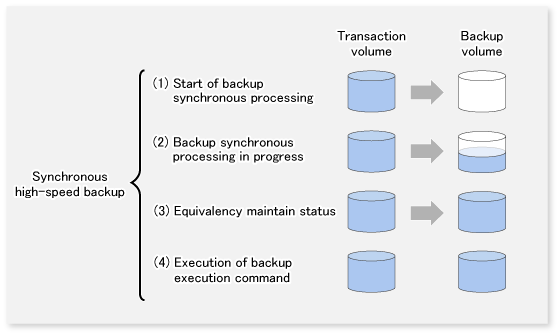The EC function of ETERNUS Disk storage system is used to copy data from a transaction volume to an unused backup volume.
To perform synchronized high-speed backup, take the following steps:
When swststartsync (Backup synchronous processing start command) is executed ((1) in the following figure), an unused backup volume with the same size as the relevant transaction volume is selected from the unused backup volume management area and backup synchronous processing begins.
The transaction and backup volumes reach an equivalent state. From this point on, equivalence between the transaction volume and backup volume is maintained. This status is referred to as equivalency maintenance status ((3) in the following figure).
When swstbackup (Backup execution command) is executed ((4) in the following figure), the backup synchronization processing stops and the backup history information is registered.
When the generation number of the newly backed up data exceeds the number of generations of backup history being kept, the oldest backup volume is treated as an unused backup volume.
Note
The swstbackup (Backup execution command) cannot be executed before the transaction and backup volumes have become equivalent.
Figure 3.3 Backup using the synchronized high-speed backup function

During synchronous high-speed backup using the Suspend/Resume function, the equivalency maintenance status of EC can be set to Suspend or Resume. The synchronous backup process is therefore faster because the function can create a differential copy from the Suspend state.
For information on the Suspend/Resume function, refer to "Chapter 4 Backup Operation using Suspend/Resume Function".
Note
If all generations of backup volumes are being managed, and if no backup volume can be obtained from the unused region in the backup volume management area, backup copies cannot be created.